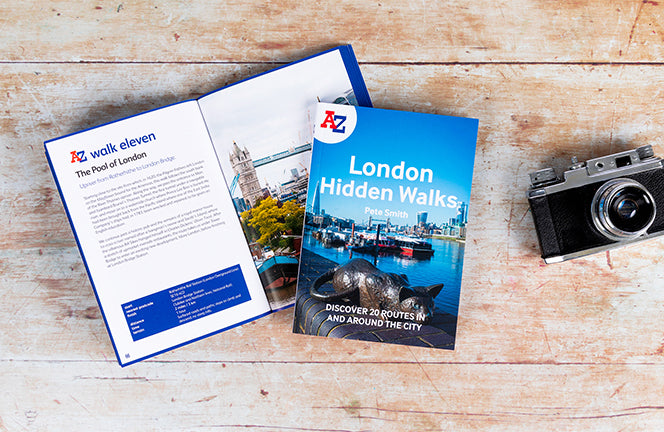A Cambridge English graduate with a lifelong interest in London, Pete Smith is married with two children and three grandchildren. After a career as a university teacher, he retrained as a London guide, and is currently a freelance lecturer and tourist guide with his own small walking tour company, London City Walks.
Preparing A-Z London Hidden Walks, blazing new trails through the capital and opening a fresh perspective on old favourites, has been a delight. It gave me a chance to revisit some of my favourite routes from the ones I had devised for my walking tour company London City Walks, add a few, and rejig them all for a wider audience. But London is such a rich and varied city that I was spoiled for choice.
London’s river walks
The river walks really chose themselves. After all, it was the Thames that led the Romans to found a city here, and for nearly two thousand years it has been London’s trading lifeblood as well as an enduring source of pleasure. The riverside walks I have selected range from the heart of the Square Mile to abandoned docks, former fishing villages and grand maritime Greenwich, and they give a panoramic view of London’s iconic landmarks.
Royal London and the West End
Another must was Royal London, with Westminster walks featuring palaces and Parliament, as well as clubland. The West End, of course, also cried out for coverage, from once scandalous Soho to ritzy Mayfair and vibrant Covent Garden, including some very upmarket retail therapy. And because London is a surprisingly green city, the book also needed to do justice to its parks: the almost rural Regent’s Park fringed by palatial terraces, Greenwich Park with its spectacular prospects of the city, and St James’s Park whose lake attracts flocks of waterfowl, has several resident pelicans and formerly even hosted a crocodile or two.
The Square Mile
But the City of London itself, the so-called Square Mile, lies at the heart of the collection. The City is where London started as a trading settlement in a new Roman province, and a walk through the City is a walk through history.
This is why, if I had to pick a favourite from these twenty walks, it would be the one I have called ‘Seething, Mincing and Staining’. Despite the destruction caused by two World Wars and a series of disastrous fires, the most memorable being the 1666 Great Fire of London, much of the Square Mile still follows the footprint of mediaeval London, and the names of its streets, lanes and alleyways echo bygone patterns of land ownership, occupation and activity. Bread Street, Milk Street and Honey Lane recall the goods that were sold just off Cheapside, which gets its name from an Anglo-Saxon word for selling or bartering, and Londoners would have bought their fish in Friday Street (since eating meat on Fridays was forbidden). Seething Lane was surrounded by ground where corn was threshed, and ‘seething’ refers to the clouds of chaff or corn husks this raised. The houses in Mincing Lane were once owned by the nuns or ‘mynchen’ of St Helen’s Priory, and Staining Lane is named for men from Staines in Middlesex who came to work in this area. Gutter Lane is where a family called Gutherun lived maybe a thousand years ago, and inedible leftovers from local butchers’ shops used to be wheeled down Pudding Lane to the Thames, ‘puddings’ being a euphemism for offal. As for Love Lane, do not ask!
Having a taste for quirkiness, I also like this walk because it includes a memorial to mice. Yet to choose a favourite London walk is as impossible as choosing a favourite child, and all the walks in this collection have their own appealing oddities: from the wombat who ate a lady’s hat to the club that welcomed Margaret Thatcher as ‘an honorary man’, and from the elephant that drank a bucket of wine a day (pink humans?) to the lamp designed to burn sewer gas. I am looking forward to sharing them.


